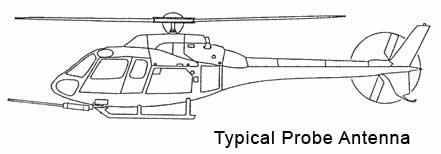 will be closed December 24th - January 2nd for the Holidays.
will be closed December 24th - January 2nd for the Holidays.
Regular business hours will resume on Monday, January 5th.
AOG Services are available.
| Part #: | |
|---|---|
| Model: | AAC-200 |
| Desc: | HF Antenna Coupler |
| OEM: | Collins Aerospace |
| NSN: | |
|---|---|
| Sched-B: | 8529109000 |
| ECCN: | |
| Cage Code: | 13499 |
 Select part number above to view pricing and availability.
Select part number above to view pricing and availability.
| Price | Condition | Availability | Stock Info | |
|---|---|---|---|---|
| Price | Cond. | Avail. | Stock Info | |
| REQUEST | SV OUTRIGHT | REQUEST LEAD TIME |
|
| Price | Condition | Availability | Stock Info | |
|---|---|---|---|---|
| Price | Cond. | Avail. | Stock Info | |
| REQUEST | SV OUTRIGHT | REQUEST LEAD TIME |
|
|
| REQUEST | SV EXCHANGE | REQUEST LEAD TIME |
|

FEATURES
SPECIFICATIONS
| TSO: | C31c, C32c | RTCA: | DO-160A |
| Dimensions: | 7.54"W x 5.06"H x 10.96"L (-001/004); 11.72"L (-003/005) | Weight: | 9.2 lb. |
| Temperature: | -40 to +55C (continuous) | Altitude: | 35000 ft. |
| Modulation: | Operates with any type modulation | Fault Indication: | Generated if tuning cycle is not complete within time to fault, or is power connector is improperly mate or disconnected |
| Warmup Time: | None | Tuning Power: | 20 +-2 W |
| Part Number: | Description: |
|---|---|
| 622-2884-001 | HF Antenna Coupler, binding post antenna connector on rear panel for grounded wire antenna |
| 622-2884-003 | HF Antenna Coupler, type HN antenna connector on rear panel |
| 622-2884-004 | HF Antenna Coupler, designed for helicopter and other high-vibration environments |
| 622-2884-005 | HF Antenna Coupler, type HN antenna connector on rear panel |
NSN: 5985-01-304-3861
| Price | Condition | Status |
|---|---|---|
| REQUEST | SV OUTRIGHT | REQUEST LEAD TIME |
NSN: 5985-01-327-1621
| Price | Condition | Status |
|---|---|---|
| REQUEST | SV OUTRIGHT | REQUEST LEAD TIME |
| REQUEST | SV EXCHANGE | REQUEST LEAD TIME |
Click on a question below to see the answer. If you have a question about this model that is not answered below, please contact questions@seaerospace.com
In relation to NE (New) parts, many OEMs change their prices and availability without any notice to dealers or the industry. Therefore, through the REQUEST or RFQ indication, we ask that customers contact us for the most accurate price and availability.
In relation to SV & OH parts, the used parts aftermarket in the aviation industry is not an infinite supply. It is a dynamic, constantly changing market that is significantly affected by and susceptible to highs and lows in supply and demand. Therefore, although we attempt to, at times, we are unable to predict the exact moment when an item may be available. Once again, through the REQUEST or RFQ indication on our website, we ask that customers contact us for the most current and accurate price and availability.
The “V” and long wire antenna configuration is the optimal HF antenna configuration. It provides consistent performance and efficiency. This configuration should not be used on very high speed fixed wing aircraftand helicopters.
The wing “V” configuration is an effective HF antenna configuration for slow and moderate speed aircraft. This configuration provides an omnidirectional radiation
Pattern. It has has the disadvantages of high drag and on low wing aircraft is prone to being walked into.
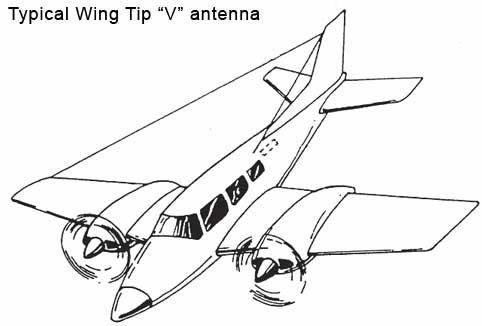
The inverted “V” antenna is recommended when a wing "V" is not practical and the antenna coupler is mounted in the back of the aircraft. The inverted “V” antenna will produce maximum signal
strength off the side of the aircraft and provide good efficiency at most frequencies. The inverted “V” produces a moderate amount of drag.
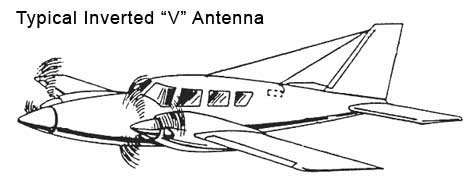
The long wire antenna is used when the HF coupler is located in the forward part of the aircraft. The long wire provides maximum signal radiation off the sides of
the aircraft and exhibit good efficiency even at the lower frequencies. Nulls in signal strength may be experienced off the nose and tail of the aircraft.
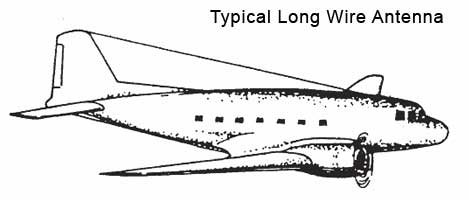
Short grounded wire antennas are primarily used on higher speed and/or high altitude aircraft. The short wire antenna have minimum drag and do not develop as high of RF voltages as the longer wire antennas. However the efficiency of the short antenna will be lower, especially at the low frequencies.
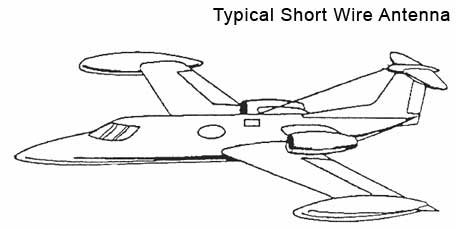
There a generally 2 types of shunt antennas. A towel bar style includes a rod or tube mounted on the airframe usually suited for helicopters.
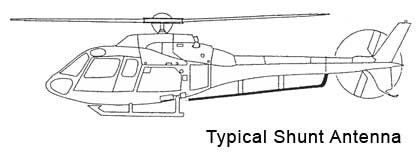
The other type of shunt antenna is designed by the aircraft manufacturer as a part of the airframe structure on the leading edge of the vertical stabilizer. Leading edge antennas are ideal for
Larger, high altitude jet aircraft.
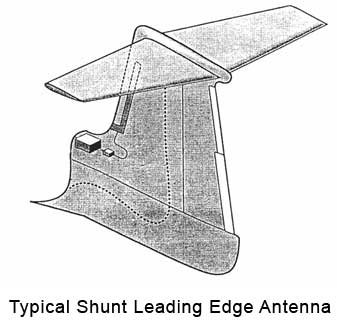
Probe HF antennas are ideal on aircraft where a long antenna is not suitable. It should be noted that probe antennas provide poor efficiency at lower frequencies as is the case with most short style antennas.
